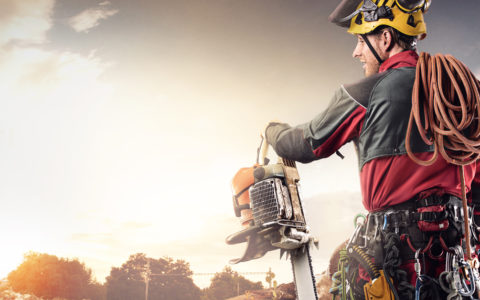In an age-old trade, it is common for arborists to rely on techniques, personal habits, and equipment that are outdated or inefficient. The dangers of the job give us a great excuse to be stubborn in our ways. There is always a risk in trying something new, but, through research and trial, many will find that innovations have made the job much safer and a heck of a lot easier.

Why Is Adapting Difficult?
The arboriculture industry is not for the weak or faint of heart. It is a dangerous job, and learning new techniques on the job can leave room for costly mistakes, both monetary and physical. As tradespeople get more experience, their muscle memory is what they rely on to keep them safe. Tying the same knot, using the same saw, wearing the same rig. Familiarity becomes survival.
Arborists can even get defensive of their tried-and-true processes which are often adapted following experiences that did not go so well. When accidents or injuries happen, we identify why they occurred and work to never let the mistake repeat itself. Thus, an unshakable routine and habit is created.
Why Adapting Is Necessary
Tradition and nostalgia hold very little ground in reasons to never learn a new way of doing the same work. Recent advances in safety and efficiency, when used, can lead to longer, safer careers and a significant boost to efficiency on the job.
1. Safety
Technology that improves safety should never be overlooked. Hearing protection is nothing new. However, it’s only been in the last few years that wireless communication has integrated with hearing conservation. Today, you can maintain continuous communication with handsfree, noise canceling headsets. Having to take your hand off the saw or ropes to talk to the crew on the ground or removing an ear plug to hear is a thing of the past.
Combining these headsets with your hard hat and earmuffs isn’t always the easiest or most comfortable solution, but they provide much-improved communication that prevents injuries and saves lives.
2. Efficiency
Some people still use friction hitches, like the Blake’s Hitch. While the Blake’s Hitch is still functional for the job, if workers lack the endurance needed to sustain that kind of physical effort, they will tire quickly. An exhausted climber can be not only inefficient but a safety hazard.
Mechanical prusiks, such as the Petzl ZIGZAG PLUS, are much more efficient, keeping your workers less physically taxed and able to focus on the job at hand.
Climbing techniques have also changed over time with the advent of new equipment. Many arborists now rely on the stationary rope system (SRS). Compared with the moving rope system/double rope technique (MRS/DRT), SRS is faster and more efficient. An SRS also makes an aerial rescue easier to execute. More and more technological innovations are focused on SRS because of the benefits of its versatility.
3. Longevity
The arboriculture industry has only a few seasoned professionals able to keep climbing through retirement. There are aspects to pruning and felling that are not conducive to a tradesperson working a full career. When arborists embrace new technologies and equipment, tasks are less labor intensive and easier on the body as a whole. Fewer accidents also prolong the average arborist’s career. The healthier the crew, the more jobs they can take on and the longer they stay with a company. This saves dollars on healthcare costs, insurance claims, and training preplacement crew.
4. Next Gen
There is value in teaching tradition to apprentices and new arborists. Having them learn the old labor-intensive techniques will help them adapt when something unexpected occurs. On the other hand, it is important to encourage the next generation to innovate and adopt techniques and tools that improve efficiency and safety. Allowing them to contribute in meaningful ways will give them a sense of ownership, as they will be the ones to carry on the trade skills to the following generation.
Additionally, a focus on innovation and efficiency can help experienced arborists learn and adapt in tandem with workers who are just getting started.

The Best Ways for Arborists to Adapt
Using new equipment in safe environments can put the aversion to change to rest. How do you take the first steps to finding what’s new in the industry? Research, like reading this article, is one way, but videos and articles can only teach you so much. Most tradespeople are tactile learners and need to have hands-on experience with new gear.
1. Expos
Attending conventions or expos is one way you can learn about the latest in technological advances in arboriculture. Vendors encourage hands-on demonstrations of their products and answer all your questions face to face. This is helpful if you are not one for scouring the internet, or if you find videos and articles to be limited in their helpfulness.
2. Rec Climbs
Attend recreational climbing (rec climbs) events either at a gym or ones specifically hosted by arborists in your community. Arborists are often eager to share their favorite techniques and equipment, making these events perfect for learning. You will be able to ask questions on the spot, instead of being stuck in a tree wondering how your new gadget works.
3. Become a Trainer
Becoming a trainer is a great way to add a competitive advantage to your business. Having the edge on giving new arborists everything they need to be successful will encourage learning about new technology and techniques. Also, adding a training program would encourage seasoned workers to try and learn safer and more efficient ways of doing the same work.
There are few advantages to complacency. While basic principles will never change, continued education in the areas of equipment and techniques should be commonplace for all arborists. If you’re ready to become an evolving arborist, you can trust Rock-N-Arbor’s extensive selection of arborist supplies to get started.

